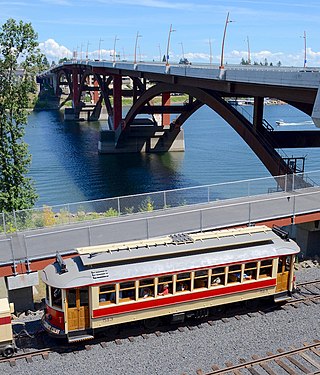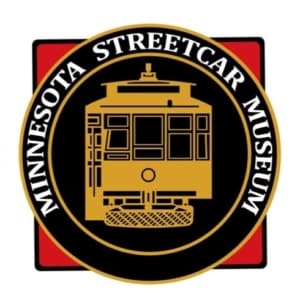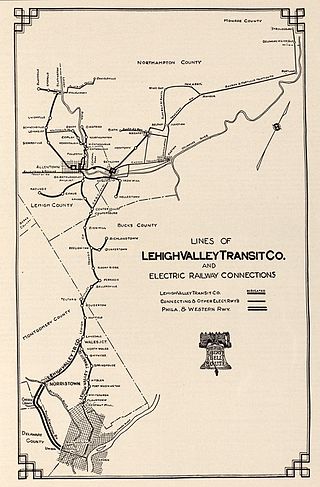
The Willamette Shore Trolley is a heritage railroad or heritage streetcar that operates along the west bank of the Willamette River between Portland and Lake Oswego in the U.S. state of Oregon. The right-of-way is owned by a group of local-area governments who purchased it in 1988 in order to preserve it for potential future rail transit. Streetcar excursion service began operating on a trial basis in 1987, lasting about three months, and regular operation on a long-term basis began in 1990. The Oregon Electric Railway Historical Society has been the line's operator since 1995.

Kenosha Area Transit is a city-owned public transportation agency based in Kenosha, Wisconsin.

Streetcars in Washington, D.C. transported people across the city and region from 1862 until 1962.

The Baltimore Streetcar Museum (BSM) is a 501(c)(3) nonprofit museum. It is located at 1911 Falls Road in Baltimore, Maryland. The museum is dedicated to preserving Baltimore's public transportation history, especially the streetcar era.

The Minnesota Streetcar Museum (MSM) is a transport museum that operates two heritage streetcar lines in Minneapolis, Minnesota, and the western suburb of Excelsior.

Streetcars or trolley(car)s were once the chief mode of public transit in hundreds of North American cities and towns. Most of the original urban streetcar systems were either dismantled in the mid-20th century or converted to other modes of operation, such as light rail. Today, only Toronto still operates a streetcar network essentially unchanged in layout and mode of operation.

The 47D Drake was a PCC trolley line that was part of the Pittsburgh Light Rail system.

The Lehigh Valley Transit Company (LVT) was a regional transport company that was headquartered in Allentown, Pennsylvania. The company began operations in 1901, as an urban trolley and interurban rail transport company. It operated successfully into the 1930s, but struggled financially during the Great Depression, and was saved from abandonment by a dramatic ridership increase during and following World War II.

The Edmonton Radial Railway (ERR) was a streetcar service that operated in Edmonton, Alberta, from 1908 to 1951. It was Edmonton's first public transit service, and later evolved into Edmonton Transit Service. Beginning as a small agency with 21 kilometres (13 mi) of track and four streetcars, the ERR would eventually operate more than 70 streetcars on over 90 kilometres (56 mi) of track, reaching most areas of the city. At its peak in 1929, the ERR served more than 14.1 million passengers.

The North Hudson Railway Company built and operated a streetcar system in Hudson County and southeast Bergen County, New Jersey before and after the start of the 20th century. It was founded by Hillric J. Bonn who became the first President in 1865 and served for 26 years until his death, and eventually taken over by the Public Service Railway. In its endeavors to overcome the formidable obstacle of ascending the lower Hudson Palisades, or Bergen Hill, it devised numerous innovative engineering solutions including funicular wagon lifts, an inclined elevated railway, an elevator and viaducts.

Streetcars in St. Louis, Missouri, operated as part of the transportation network of St. Louis from the middle of the 19th century through the early 1960s.

The Ninth Avenue derailment, on the Ninth Avenue Elevated in Manhattan on September 11, 1905, was the worst accident on the New York City elevated railways, resulting in 13 deaths and 48 serious injuries.

The Norwich and Westerly Railway was an interurban trolley system that operated in Southeastern Connecticut during the early part of the 20th century. It operated a 21-mile line through rural territory in Norwich, Preston, Ledyard, North Stonington, and Pawcatuck, Connecticut to Westerly, Rhode Island between 1906 and 1922. For most of its length, the route paralleled what is now Connecticut Route 2.

Birney Safety Streetcar No. 224 is a streetcar in Fort Smith, Arkansas, listed on the U.S. National Register of Historic Places. Built in 1926 by the American Car Company division of the J. G. Brill Company, it is a type of streetcar known as a Birney "Safety Car". It was listed on the National Register in 1994 and is one of fewer than 10 streetcars listed.

The Astoria Riverfront Trolley is a 3-mile (4.8 km) heritage streetcar line that operates in Astoria, Oregon, United States, using former freight railroad tracks along or near the south bank of the Columbia River, with no overhead line. The service began operating in 1999, using a 1913-built streetcar from San Antonio, Texas. As of 2012, the service was reported as carrying 35,000 to 40,000 passengers per year and has been called a "symbol" and "icon" of Astoria. The line's operation is seasonal, normally during spring break and from May through September.
Streetcars were the primary mode of public transport in Tacoma, Washington, United States from the late 1800s until their discontinuance in 1938. Operated together with a network of interurbans, streetcars provided transport within Tacoma and throughout the Puget Sound region. Buses replaced the last streetcars in 1938. Streetcar-type transportation returned to Tacoma in 2003 with the opening of the Tacoma Link, a 4-mile (6.4 km) light rail line in Downtown Tacoma. There are proposals both to expand this system and to construct a new heritage streetcar system.

The Madison Street bridge disaster occurred on November 1, 1893, in Portland, Oregon, United States, when a westbound streetcar drove off the open draw of the first Madison Street Bridge. Seven people died. This remains the worst streetcar accident ever to occur in the city of Portland and also the worst bridge disaster in Portland history.

On November 7, 1916, a streetcar loaded with passengers ran off the open Summer Street Bridge, a drawbridge, into Fort Point Channel near downtown Boston, Massachusetts, United States. Forty-six passengers were killed, making it the deadliest disaster in Boston's history until surpassed by the Cocoanut Grove fire in 1942.

The Fillmore Counterbalance was a streetcar device operated by the Market Street Railway (MSRy) in San Francisco. It aided the company's 22 Fillmore line in traversing the steep northern slope of Fillmore Street from 1895 to 1941. The weight of a descending car helped lift ascending cars. It was a unique operation for its use of mechanical cable haulage for an otherwise electrically-powered route.



















